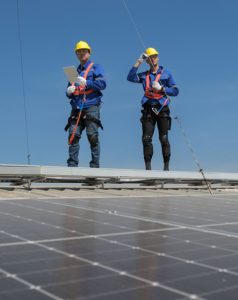Workforce Challenges Impact the Solar Industry’s Bright Future
 The United States is on the cusp of a solar energy transformation. Growth in the solar industry in the U.S. has skyrocketed over the past 10 years, and recent federal legislation and sustainability initiatives have catapulted industry demand to new heights.
The United States is on the cusp of a solar energy transformation. Growth in the solar industry in the U.S. has skyrocketed over the past 10 years, and recent federal legislation and sustainability initiatives have catapulted industry demand to new heights.
Advances in technology have also benefited the industry: The cost to manufacture, install and maintain solar modules has come down, making it an attractive alternative for both commercial and residential customers.
Expansion in the industry shows no sign of abating and is expected to quadruple in the coming decade. Still, challenges exist going forward. Despite recent gains and the influx of investment, solar companies are facing adversity finding skilled craft professionals needed to install and maintain systems on a growing number of projects.
To move the industry forward and meet the rising demand, there must be a greater focus on how to attract and train new talent in the solar energy sector.
Legislation and Innovation are Fueling Solar Demand
In 2021, the Bipartisan Infrastructure Law was signed, part of which allocated $73 billion toward the overhaul of the country’s power infrastructure. Less than a year later, the Inflation Reduction Act (IRA) was also signed, focusing in part on energy security and climate change and dedicating $783 billion toward the issues. The two bills coupled together provide the underpinnings to address the United States’ dependence on fossil fuel, drive down greenhouse gas emissions and create new jobs.
Since the signing of the laws, money has poured into the renewable energy sector and the solar power industry has seen tremendous growth.
In 2023, the U.S. solar industry increased 51% from the year prior; it was the nation’s peak year for solar installations. Recovering from supply-chain limitations that had suppressed growth in 2022, the utility-scale sector (i.e., electrical plants) drove a large portion of the expansion, while residential sector installations also saw healthy growth. Overall, the capacity of new electricity generated by solar accounted for 53% to the U.S. electric grid in 2023.
Solar installation is expected to remain robust in the next four years, with the industry’s average annual growth projected at 7% between 2024 and 2028. In a more extended outlook, the Solar Energy Industries Association® (SEIA) reports that by 2033, the U.S. solar capacity will grow enough to power every home east of the Mississippi River.
Workforce Shortages Create Challenges for Sector Growth
With growing investment and favorable growth projections, the future appears bright for the solar energy sector.
However, underlying that positive outlook is the undeniable recognition that not enough skilled professionals are available to build, install and maintain the solar infrastructure. With the rapid pace of growth in the industry, the availability of qualified talent has not risen to meet the demand. The workforce is understaffed, and companies are struggling to hire the talent they need — 44% of solar industry employers said it was “very difficult” to find qualified applicants.
If the workforce shortage and skills gap issues maintain current trends, they pose a significant risk to meeting the renewable energy goals that have been set. The SEIA says for solar to reach 30% of domestic electricity generation by 2030, the workforce needs to grow to “more than a million workers.”
Implementing Solar Training Solutions
To overcome the challenges caused by the current workforce shortages, electrical and solar training programs will need to be developed, invested in and utilized.
 One solution for solar training comes from the National Center for Construction Education and Research (NCCER). NCCER’s Solar Photovolatic System Installer curriculum has recently been updated and modernized with insights from subject matter experts (SMEs) from the industry. The revised content features expanded coverage of commercial and industrial applications for solar photovoltaic technology and enhanced residential content such as heat pumps and home-wide efficiency strategies.
One solution for solar training comes from the National Center for Construction Education and Research (NCCER). NCCER’s Solar Photovolatic System Installer curriculum has recently been updated and modernized with insights from subject matter experts (SMEs) from the industry. The revised content features expanded coverage of commercial and industrial applications for solar photovoltaic technology and enhanced residential content such as heat pumps and home-wide efficiency strategies.
Anticipation for a comprehensive solar training solution has been building for organizations ranging from smaller schools to large nationwide contractors. Workforce development options in the solar sector have been limited, often forcing programs to splice together content from multiple crafts or sources to meet their needs.
Derek Sams, apprenticeship program manager for Mortenson Construction, has been among those in the industry eager for NCCER’s updated curriculum.
“I would say five or six years ago we knew we needed to start doing more training, better training for these workers,” Sams said.
While solar technology had already been trending upward in the industry, Sams said the introduction of the recent infrastructure legislation has since “super-sized” the demand.
Sams also noted that solar installer is not yet a federal apprenticeable occupation that can be registered with the Department of Labor, leading to additional challenges for building a sufficient program. Mortenson’s Texas-based apprenticeship program hopes to incorporate modules from NCCER’s new Solar Photovoltaic Installer curriculum into their existing apprenticeship tracks for construction laborer and electrician, helping to qualify workers for upcoming projects.
The Path to a Sustainable Solar Workforce
The U.S. Department of Energy puts it like this: “Deploying safe, reliable solar energy systems requires a skilled workforce that is properly trained to design and install these technologies. Additionally, maintaining these systems across decades of expected operation requires experienced technicians who can identify and address any safety or performance issues.”
And this is the conundrum the solar industry faces at the moment: The current number and quality of solar installation education programs do not appear to be enough to meet the skyrocketing demand nationwide.
Training and apprenticeship programs need to be built out and developed for the solar sector to flourish and meet its needs and goals. Highly trained craft professionals with the right skills and knowledge are vital to execute the transformation of American energy through construction and maintenance. A high degree of technical expertise and understanding are essential in the solar energy field — and the only way to build a qualified workforce is through recruitment and training.
With growing demand for power worldwide, an aging electrical grid that requires substantial infrastructure upgrades, and green initiatives that call for net-zero emissions by 2050, the energy sector is at a critical pivot point. Just as we are investing time, money and resources into major infrastructure projects, we must also invest in the people who will get them done.
Want to learn more about solar training and apprenticeship solutions from NCCER? Click here.

